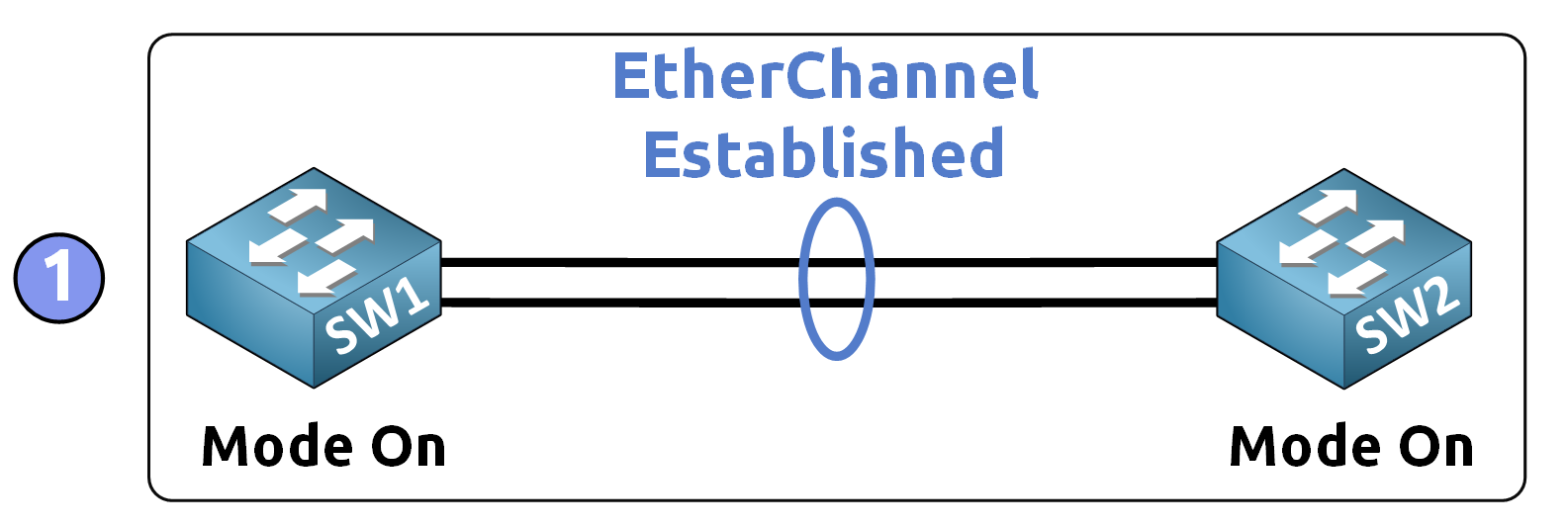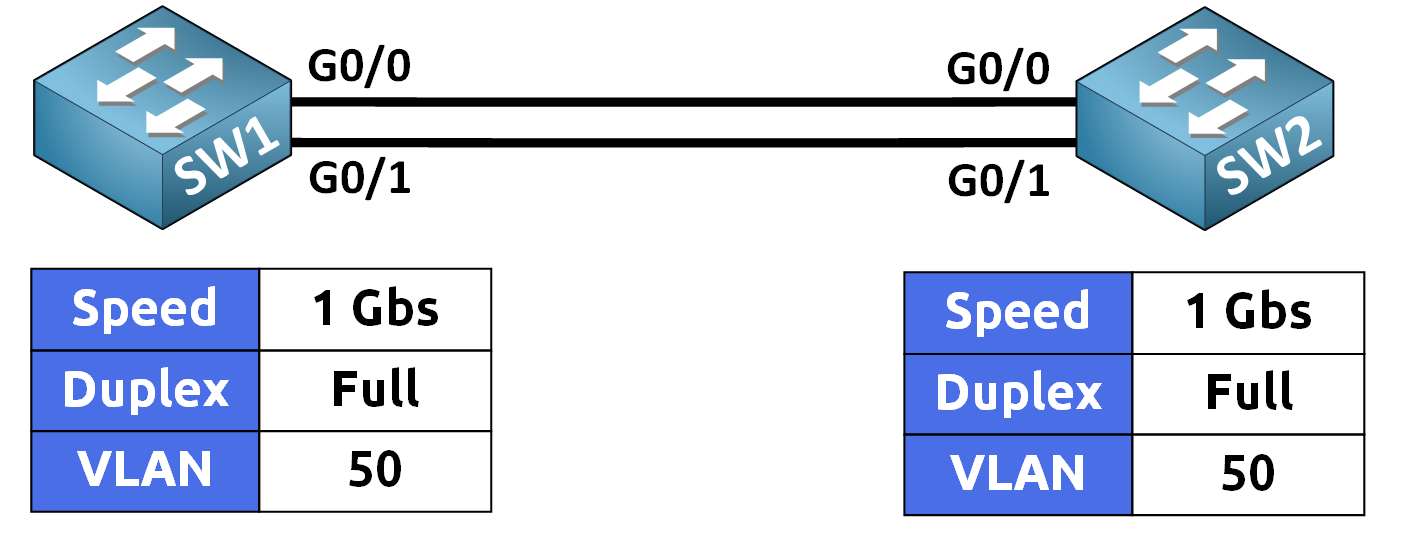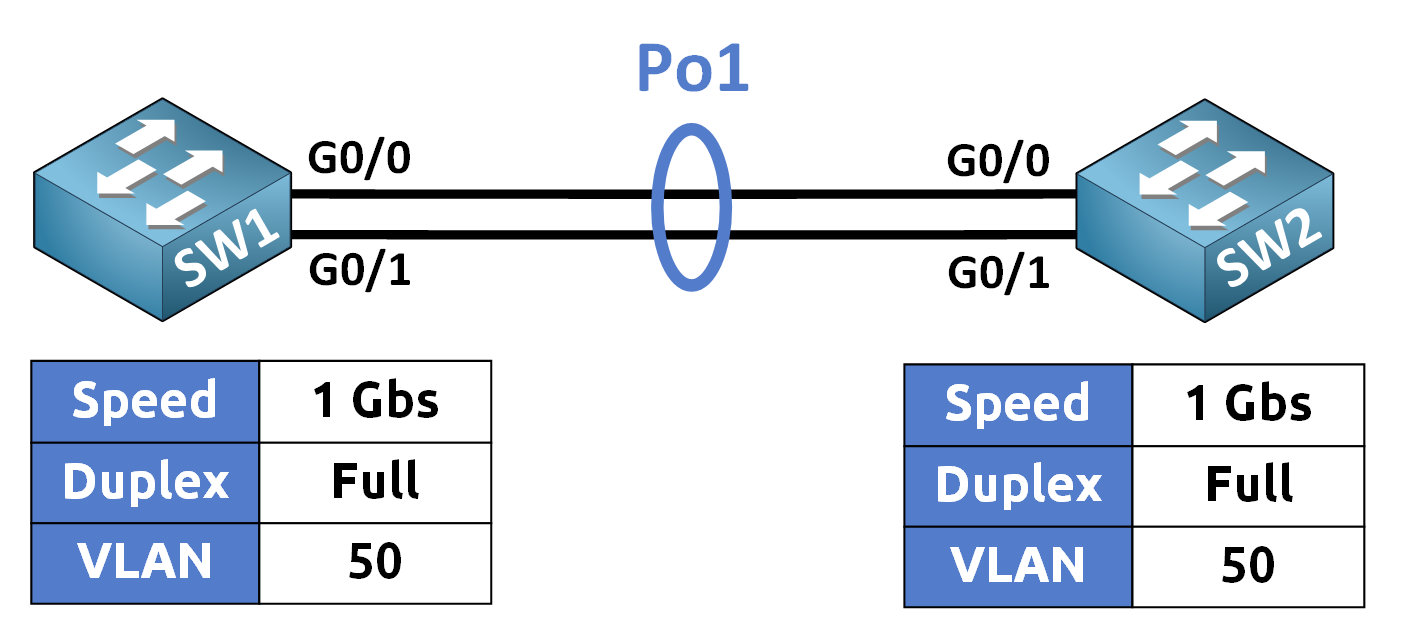Static EtherChannel
Course Contents
1. Introduction to Static EtherChannel
In this course, we will go step by step through the configuration of Static EtherChannel. Unlike PAgP or LACP, Static EtherChannel does not require any negotiation between switches.

Interfaces are statically grouped using the on mode at both ends. This configuration will also include setting up interfaces as trunks and allowing VLAN 50 on the trunk.
Prerequisites for Configuration
Before starting, ensure the following conditions are met:
- Interface Consistency: All interfaces in the EtherChannel must have the same speed, duplex, and interface type.
- VLAN and Trunking: For Layer 2 links, interfaces must be in the same VLAN or have identical trunk settings.
- Active Links: Ensure that each physical link is operational.

2. Steps to Configure Static EtherChannel
We will configure Static EtherChannel by activating on mode, configuring interfaces as trunks, and allowing VLAN 50 on the trunk for demonstration purposes.
🔹 Enter Interface Configuration Mode
Select the interfaces that will form the EtherChannel on each switch.
- On SW1:
SW1(config)# interface range g0/0 - 1
- On SW2:
SW2(config)# interface range g0/0 - 1
🔹 Set Static EtherChannel Mode
The on mode creates an EtherChannel without any negotiation protocol. This means both switches must be manually configured for EtherChannel to work. Configure it on both switches:
- SW1:
SW1(config-if-range)# channel-group 1 mode on
- SW2:
SW2(config-if-range)# channel-group 1 mode on
After this command is applied, a logical interface called Port-Channel 1 (Po1) is created on each switch !
🔹 Configure Trunk Mode and VLAN
For this example, Port-Channel 1 must be configured as a trunk, using 802.1q encapsulation, and allowing VLAN 50 for traffic.
- SW1:
SW1(config)# interface port-channel 1 SW1(config-if)# switchport trunk encapsulation dot1q SW1(config-if)# switchport mode trunk SW1(config-if)# switchport trunk allowed vlan 50
- SW2:
SW2(config)# interface port-channel 1 SW2(config-if)# switchport trunk encapsulation dot1q SW2(config-if)# switchport mode trunk SW2(config-if)# switchport trunk allowed vlan 50
3. Verifying the Configuration
Use the following command to check if EtherChannel is correctly formed:

- SW1:
SW1# show etherchannel summary
Flags: D - down P - in port-channel
I - stand-alone S - suspended
H - Hot-standby (LACP only)
R - Layer3 S - Layer2
U - in use N - not in use, no aggregation
f - failed to allocate aggregator
M - not in use, minimum links not met
m - not in use, port not aggregated due to minimum links not met
u - unsuitable for bundling
w - waiting to be aggregated
d - default port
Group Port-channel Protocol Ports
------ ------------- ----------- ----------------------------------------------
1 Po1(SU) - Gi0/0(P) Gi0/1(P)
Here you can see the Port-Channel 1 (Po1) is active in Layer 2 mode (S) and is up (U), with no protocol displayed, indicating Static (On) mode, and that the interfaces Gi0/0 and Gi0/1 are successfully included in the EtherChannel.
- SW2:
SW2# show etherchannel summary
Flags: D - down P - in port-channel
I - stand-alone S - suspended
H - Hot-standby (LACP only)
R - Layer3 S - Layer2
U - in use N - not in use, no aggregation
f - failed to allocate aggregator
M - not in use, minimum links not met
m - not in use, port not aggregated due to minimum links not met
u - unsuitable for bundling
w - waiting to be aggregated
d - default port
Group Port-channel Protocol Ports
------ ------------- ----------- ----------------------------------------------
1 Po1(SU) - Gi0/0(P) Gi0/1(P)
As well on SW2, the Port-Channel 1 (Po1) is active in Layer 2 mode and operational (indicated by SU), with no protocol listed, confirming Static (On) mode, and the interfaces Gi0/0 and Gi0/1 are part of the EtherChannel.
Verify the Trunk Configuration
To verify that the trunk is correctly configured on the Port-Channel interface and that VLAN 50 is permitted, use the show interfaces trunk command.
- SW1:
SW1# show interfaces trunk
Port Mode Encapsulation Status Native vlan
Po1 on 802.1q trunking 1
Port Vlans allowed on trunk
Po1 50
The output shows that Port-Channel 1 (Po1) is active as a trunk with 802.1q encapsulation, and VLAN 50 is successfully permitted on the trunk.
- SW2:
SW2# show interfaces trunk
Port Mode Encapsulation Status Native vlan
Po1 on 802.1q trunking 1
Port Vlans allowed on trunk
Po1 50
The output verifies that Port-Channel 1 (Po1) on SW2 is active as a trunk with 802.1q encapsulation, and VLAN 50 is successfully permitted on the trunk.
4. Conclusion
The Static EtherChannel configuration is now complete!
- Port-Channel 1 (Po1) aggregates two physical interfaces into one logical link.
- Trunk mode is properly configured, allowing VLAN 50 traffic
. - Increased bandwidth and redundancy by utilizing both interfaces efficiently.

⚠️ Important reminder: Since Static EtherChannel uses
onmode, both sides must be manually configured correctly. If there is a mismatch, it can lead to connectivity issues.
Next Lesson: We will explore LACP EtherChannel, which provides dynamic negotiation and better flexibility!
